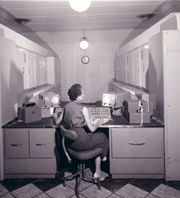
Ferranti Mark 1
The Ferranti Mark 1, also known as the Manchester Electronic Computer in its sales literature,[1] and thus sometimes called the Manchester Ferranti, was produced by British electrical engineering firm Ferranti Ltd. It was the world's first commercially available electronic general-purpose stored program digital computer.[a]
Also known as
Although preceded as a commercial digital computer by the BINAC and the Z4, the Z4 was electromechanical and lacked software programmability, while BINAC never operated successfully after delivery[2]
The Ferranti Mark 1 was "the tidied up and commercialised version of the Manchester Mark I".[3] The first machine was delivered to the Victoria University of Manchester in February 1951[4] (publicly demonstrated in July)[5][6] ahead of the UNIVAC I which was delivered to the United States Census Bureau in late December 1952, having been sold on 31 March 1951.[7]
Mark 1 Star[edit]
After the first two machines, a revised version of the design became available, known as the Ferranti Mark 1 Star or the Ferranti Mark 1*. The revisions mainly cleaned up the instruction set for better usability. Instead of the original mapping from holes to binary digits that resulted in the random-looking mapping, the new machines mapped digits to holes to produce a much simpler mapping, ø£½0@:$ABCDEFGHIJKLMNPQRSTUVWXYZ. Additionally, several commands that used the index registers had side effects that led to quirky programming, but these were modified to have no side effects. The original machines' JUMP instructions landed at a location "one before" the actual address, for reasons similar to the odd index behaviour, but these proved useful only in theory and quite annoying in practice, and were similarly modified. Input/output was also modified, with five-bit numbers being output least significant digit to the right, as is typical for most numeric writing. These, among other changes, greatly improved the ease of programming the newer machines.
The Mark 1/1* weighed 10,000 pounds (5.0 short tons; 4.5 t).[11]
At least seven of the Mark 1* machines were delivered between 1953 and 1957,[9] one of them to Shell labs in Amsterdam.[12] Another was installed at Avro, the aircraft manufacturers, at their Chadderton factory in Manchester. This was used for work on the Vulcan among other projects.
Conway Berners-Lee and Mary Lee Woods, the parents of Tim Berners-Lee, inventor of the World Wide Web, both worked on the Ferranti Mark 1 and Mark 1*.[13]
Computer music[edit]
Included in the Ferranti Mark 1's instruction set was a hoot command, which enabled the machine to give auditory feedback to its operators. The sound generated could be altered in pitch, a feature which was exploited when the Mark 1 made the earliest known recording of computer-generated music, playing a medley which included "God Save the King", "Baa Baa Black Sheep", and "In the Mood".[14] The recording was made by the BBC towards the end of 1951, with the programming being done by Christopher Strachey, a mathematics teacher at Harrow and a friend of Alan Turing. It was not, however, the first computer to have played music; CSIRAC, Australia's first digital computer, achieved that with a rendition of "Colonel Bogey".[15]